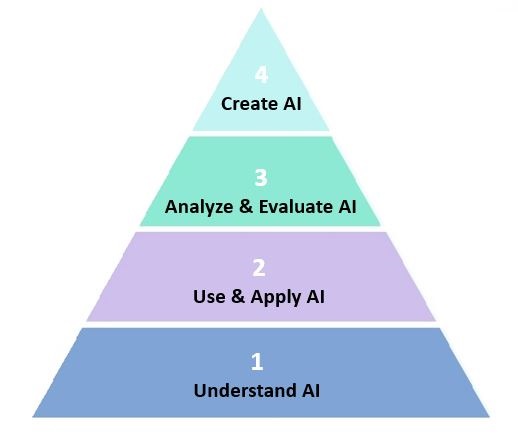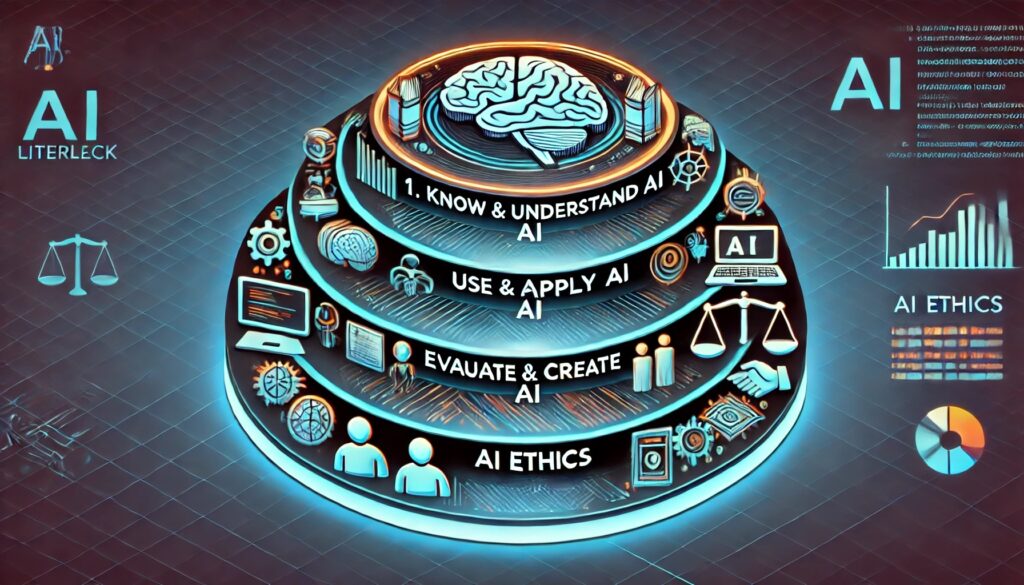Applications of artificial intelligence (AI) are part of our daily lives. From smart home devices to virtual assistants like Google and Siri, AI applications are ubiquitous. As AI-generated content becomes more common in many professions, students will need to be skilled in using it. How can we help students develop critical thinking skills, especially when evaluating AI-generated outputs and tools?
Framing AI Literacy
AI literacy is a newly emerging concept extending from traditional literacies (reading and writing) and digital literacies, such as evaluating and creating digital media, and navigating digital platforms and tools. This blog highlights a framework, adopted by Educause (2024), for AI literacy that builds upon Bloom’s Taxonomy. The framework provides steps to engage with AI while drawing attention to the human aspect of digital technologies and encourages using a critical lens when engaging with generative AI.

The AI literacy framework suggests four levels: (1) Understand AI, (2) Use & Apply AI, (3) Analyze & Evaluate, and (4) Create AI (Ng et al., 2021). While each level builds upon the concepts from the previous one, it’s not necessary to master everything before moving to the next. It is also important to keep in mind that there are many types of AI, although higher education discussions often focus on generative AI, such as ChatGPT, DALL-E, Microsoft Copilot, and Adobe Firefly.
Level 1. Understand AI
- Understand the basic functions of AI and how to use AI applications.
- Define key AI terms: artificial intelligence, machine learning, large language models (LLMs), and neural networks.
- Understand technical frameworks, including open vs. closed models, types of AI, and how generative AI (GenAI) works.
- Consider the limitations, risks, and ethical concerns related to GenAI.
- Explore how GenAI impacts academic integrity, the workplace, and the future skills needed for these technologies.
Review our blogs that introduce AI basics, key terms, academic integrity, and limitations: Questions about ChatGPT and Generative Artificial Intelligence (AI), Academic Integrity and Generative AI: Best Practices, Beyond ChatGPT – AI Poll Results, and Recharging Assessment with Generative Artificial Intelligence.
Level 2. Use & Apply AI
- Apply AI knowledge, concepts, and applications in different scenarios.
- Understand prompt engineering, context windows, hallucinations, bias, zero-shot, and few-shot prompting.
- Experiment with prompt engineering and refine prompts by adding specificity and context for meaningful outputs.
- Consider privacy, confidentiality, and copyright when inputting information into prompting tools.
- Evaluate AI outputs for inaccuracies.
Refer to our blogs that support experimentation and prompt engineering: Practical Prompting for Teaching and Learning, Navigating Digital Technology in Teaching and Learning, Academic Integrity and Generative AI: Best Practices, and The Not-So-Scary Gen AI Image Competition.
Level 3. Anayze and Evaluate AI
- Critically evaluate AI outputs for bias and inaccuracies, and verify sources, copyright, and other issues beyond the prompt.
- Consider the implications of AI in the context of your field or discipline, and understand how AI intersects with other fields.
- Argue in support of, or against, the creation, use, and application of AI.
- Examine the ethics of AI from different perspectives, such as environmental sustainability, privacy, copyright, misinformation, labor, and bias.
The resources on this page (below) can help you discuss generative AI with students, analyze its impact, and evaluate its use as we work towards building levels 1-2-3; we are working towards level 4 at this time, although this may not be a learning outcome in all teaching and learning contexts.
Level 4. Create AI
- Engage with AI at a creator level to create new LLMs and leverage AI to develop new systems.
- Envision new applications for AI.
- Propose theories about AI.
The image was produced with OpenAI. (2023). DALL-E (Version 3) [Artificial intelligence system]. Prompt: Create an image to describe an AI literacy framework based on Bloom’s Taxonomy. There are four interconnected levels, ordered as follows: 1. ‘AI Ethics’ at the top, 2. ‘Evaluate & Create AI,’ 3. ‘Use & Apply AI,’ and 4. ‘Know & Understand AI’ at the bottom. Use a tech-inspired color scheme.
Note that the text is distored and incomplete because DALLE-E has limitations when it come to text generation with images.

Resources to Build AI Literacy
The resources below (1-2-3) can serve as tools to facilitate conversations with students about generative AI in your learning environments, helping to build digital literacy.
1. Ready to Use Generative AI Checklist [word file]
This checklist is for students to use before engaging with generative AI (genAI). It prompts students to reflect on their purpose and consider if and how genAI can enhance their learning experience. Additionally, the checklist suggests that students familiarize themselves with genAI’s capabilities, ethical use, and potential risks. Please download and adapt for your use.
2. Generative AI in your course [PowerPoint]
The PowerPoint is a guide for classroom conversations about generative AI in your course. Please download and adapt for your use.
3. The Assignment Dilemma: Using GenAI Productively [OPEN Resource – Genially interative presentation].
This online interative lesson delves into the ethical considerations of Generative Artificial Intelligence.
Join the Conversation
Currently, there are no rules requiring faculty to use or avoid AI in their learning environments. However, they are encouraged to clarify and discuss their expectations regarding AI in assignments. The use of AI surveillance technology to monitor academic integrity is strongly discouraged due to biases and the unreliability of plagiarism detection tools.
We have developed and implemented programming on various AI topics for the VIU community. This includes facilitating generative AI syllabus statements for faculty, hosting an AI mini-conference with a guest panel, and conducting sandbox sessions to test different text- and image-based AI tools. Additionally, we have created a series of blogs featuring linked open resources, conducted workshops, led departmental conversations, and facilitated classroom discussions with students. We also launched competitions to encourage faculty to experiment with AI.
This process is ongoing and iterative, adapting as tools evolve and the VIU community needs change. We invite you to join the conversation, share your experiences in teaching and learning with AI, and get in touch with us.
Attributions
This blog page has been adapted from:
Generative Artificial Intelligence in Teaching and Learning Copyright © 2023 by Centre for Faculty Development and Teaching Innovation, Centennial College is licensed under a Creative Commons Attribution 4.0 International License, except where otherwise noted.
Generative Artificial Intelligence in Teaching and Learning at McMaster University Copyright © 2023 by Paul R MacPherson Institute for Leadership, Innovation and Excellence in Teaching is licensed under a Creative Commons Attribution 4.0 International License
Future Facing Assessments by Eliana Elkhoury and Annie Prud’homme-Généreux is licensed under CC BY 4.0
How Should we Talk to Students About AI? by Monash University is licensed under CC BY-NC-SA 4.0
Hibbert, M., Altman, E., Shippen, T., and Wright, M. A framework for AI Literacy (2024). Educause Review. A Framework for AI Literacy | EDUCAUSE Review
Ng, D. T. K., Leung, J. K. L., Chu, S. K. W., & Qiao, M. S. (2021). Conceptualizing AI literacy: An exploratory review. Computers and Education: Artificial Intelligence, 2, 100041. https://doi.org/10.1016/j.caeai.2021.100041